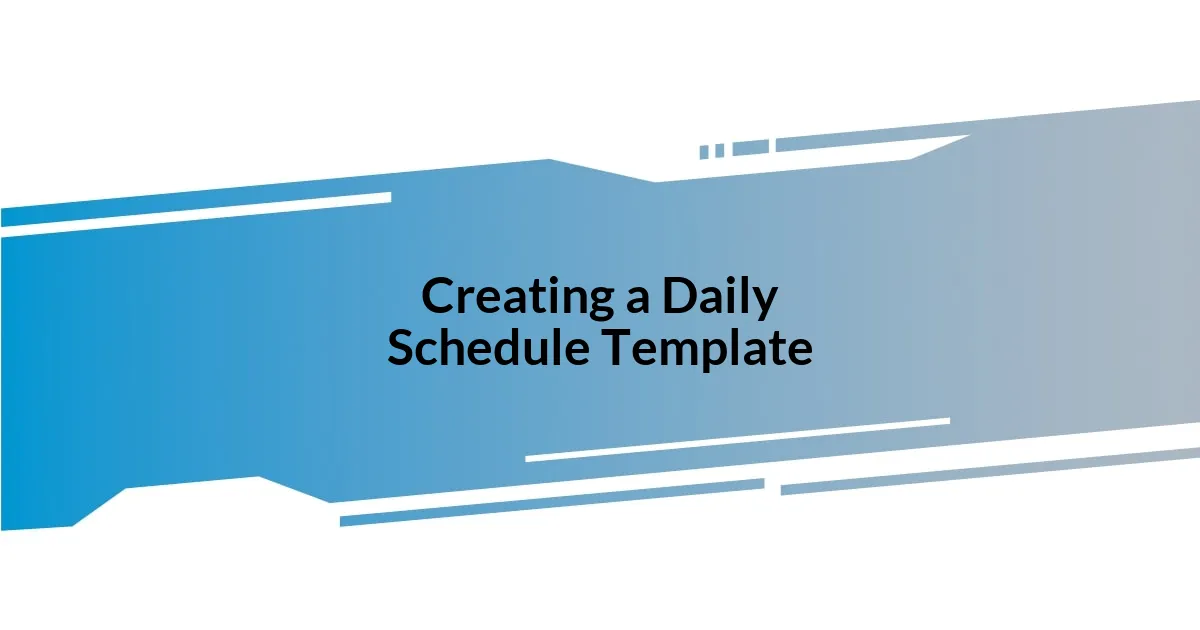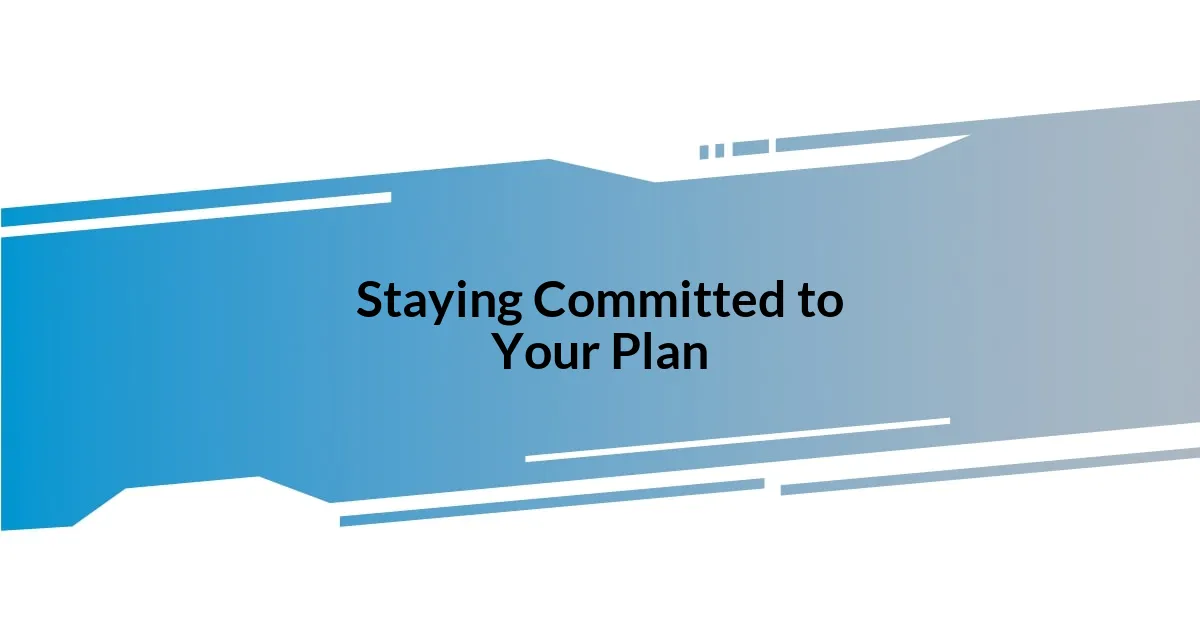Key takeaways:
- Recognizing personal energy patterns is essential for effective task scheduling, enhancing productivity and fulfillment.
- Incorporating flexibility in planning allows for adaptability in response to unexpected challenges, promoting resilience and creativity.
- Selecting the right mix of planning tools, both digital and analog, streamlines organization and reduces stress.
- Regularly reviewing goals and incorporating personal reflection fosters emotional health and improves overall planning effectiveness.

Understanding Personal Planning Needs
Understanding my personal planning needs has been a journey filled with insights and revelations. I vividly remember the days when I’d overload my calendar with tasks, only to find myself overwhelmed and drained. What did I learn from that experience? It’s crucial to prioritize tasks based on what truly matters to me, and this realization has profoundly shaped my planning style.
As I think about what drives me, I ask myself: How do my energy levels fluctuate throughout the week? For instance, I’ve noticed I’m much more focused in the mornings, which is why I dedicate that time to tackling significant projects. This awareness has not only boosted my productivity but also brought a sense of fulfillment. In this personal journey, I’ve come to understand that recognizing these patterns can make all the difference in creating a schedule that works for me.
Some people thrive on structure while others prefer flexibility, and I fall somewhere in between. Once, I had a tightly packed schedule that left no room for spontaneity. It felt suffocating! Now, I build in buffer times, allowing space for creativity or unexpected opportunities. By tailoring my planning to meet my needs, I feel more in control of my time and less like a slave to my calendar. Isn’t it refreshing to think that we can craft our schedules to reflect our true selves?

Identifying Key Time Blocks
Identifying key time blocks in my day has been a game-changer for my planning efficiency. I remember a time when I’d juggle various tasks without a clear sense of priority. Now, I group similar activities together, which helps maintain my focus. For example, I allocate a solid two-hour block each afternoon for creative work, during which I can truly immerse myself in projects without interruptions.
I’ve also found that not all time blocks are created equal. Some days, I wake up energized, ready to tackle complex tasks, while on others, I feel more drained. By maintaining flexibility in my schedule, I can adjust the key time blocks to better match my energy levels. This adaptability has allowed me to approach tasks with vigor rather than fatigue.
Reflecting on my past experiences, I now realize that the best time blocks align with both my productivity patterns and personal commitments. For instance, I leave evenings free for family or leisure activities, creating a balance that enhances my overall well-being. Not every day looks the same, but knowing how to identify and adjust my key time blocks keeps me feeling centered and productive.
| Time Block Type | Benefits |
|---|---|
| Mornings | High focus, ideal for complex tasks |
| Afternoons | Creative work time, less distractions |
| Evenings | Personal time, family engagement, relaxation |

Selecting Effective Planning Tools
Selecting the right planning tools has transformed my scheduling experience significantly. I used to overlook this aspect entirely until I encountered a chaotic week where my digital and paper planners clashed, leading to confusion rather than clarity. It was then that I understood the importance of choosing tools that not only resonate with my personal style but also enhance my productivity. For me, it’s about finding the perfect blend of digital and analog options.
Here are some planning tools and their benefits that I’ve found effective:
- Digital Calendars (like Google Calendar): Offers reminders and color-coding features to keep my priorities in check.
- Bullet Journals: Allows creative expression while providing a tangible way to track my goals and progress, keeping me grounded.
- Task Management Apps (such as Todoist): Help me organize my tasks by priority and deadlines, making it easy to adjust on the fly when life gets unpredictable.
- Physical Planners: There’s something satisfying about writing things down, giving me a sense of control over my day that screens sometimes fail to provide.
Finding the right mix has not only refined my planning process but has also alleviated much of the stress I once felt. Each tool I use now feels purposeful, tailored to my needs, and, most importantly, they bring me joy in the organization. It’s a truly liberating feeling to have control over my schedule!

Creating a Daily Schedule Template
Creating a daily schedule template is, for me, the foundation of a productive day. I start by mapping out my essential tasks and responsibilities, ensuring I can visualize where my time will go. One year, I tried a color-coded system—using different hues for work, personal time, and family activities—and it was a real eye-opener. Have you ever noticed how colors can evoke emotions? I found that seeing my day organized in vibrant shades not only made planning more enjoyable but also helped me prioritize what truly mattered.
I also like to include time for breaks in my daily schedule template, which has been crucial for maintaining my energy levels. During those initial days of planning, I felt guilty stepping away from my tasks, thinking I was wasting precious time. But I quickly learned that short breaks recharge my mind. For example, I often schedule a ten-minute walk after completing a major task. It’s those little moments away that allow me to return refreshed and ready to tackle the next challenge. What about you? Do you give yourself those moments to breathe?
One of my favorite aspects of creating my daily schedule template is the freedom to tweak it as my needs evolve. I remember a particularly intense work week where I needed to shuffle things around last minute. Initially, I panicked, thinking it would throw everything off track. However, I realized that this adaptability can be a blessing. By revisiting my template and adjusting my time blocks, I emerged more resilient than ever. Embracing this fluidity in my scheduling has truly changed my approach to planning. Do you ever find yourself adjusting plans on the fly? It’s a skill worth honing!

Incorporating Flexibility and Review
Incorporating flexibility into my planning schedule has been a game changer. I remember one week where everything that could go wrong did—a car breakdown, a sudden deadline, and it all sent my well-structured plan into disarray. Initially, I felt overwhelmed, but when I gave myself permission to pivot and adapt, everything became manageable. Wouldn’t it be great if we could transform unexpected challenges into opportunities for growth? I realized that being flexible isn’t just about moving tasks around; it’s about cultivating a mindset that embraces change.
Regularly reviewing my schedule also plays a crucial role in maintaining that balance. I make it a practice to reflect on my week every Sunday. In those moments, I revisit my goals, assess what worked, and identify any roadblocks I faced. It’s a little like tuning an instrument; the more I refine my approach, the better my performance becomes. Does this resonate with your experience? I find that this time also helps me celebrate my accomplishments, no matter how small, and it reminds me to adjust my upcoming week based on my insights.
I’ve learned to embrace that a perfectly structured schedule is an illusion; the real beauty lies in how we dance with our plans. I recall a day when I had all intentions to focus on writing. However, a friend reached out needing help with a personal project. Instead of sticking to my rigid plan, I chose to lend an ear and provide support. That day turned into a beautiful exchange of ideas, ultimately fueling my own creativity later. How often do we hold so tightly to our plans that we miss these wonderful moments? Flexibility allows us not only to accommodate the unexpected but to embrace life’s spontaneity, enriching our experiences beyond what we initially envisioned.

Customizing Your Weekly Overview
Customizing my weekly overview is where the real magic happens in my planning process. I like to start by blocking out my non-negotiable commitments—like meetings and family time—because these are the anchors of my week. It’s fascinating how visually placing these blocks helps me grasp the overall rhythm of my days. Have you ever mapped your week only to discover a surprising pattern? That discovery can make your schedule feel less like a chore and more like a thoughtfully curated experience.
I always incorporate a dedicated space for personal reflection within my weekly overview. Last month, I decided to set aside Sundays to jot down my thoughts and feelings about the past week. It was during one of those quiet moments of reflection that I realized this was crucial for my well-being. Instead of merely looking ahead, I was also honoring my past experiences. How often do we take time to acknowledge our feelings amidst the hustle and bustle? This practice not only enhances my planning but nurtures my emotional health, and I recommend it to anyone feeling overwhelmed.
Another key aspect for me is weekly themes. I once experimented with dedicating specific days to particular focuses—like “Mindful Mondays” for self-care and “Tackle-It Tuesdays” for tackling projects head-on. This not only added a sense of excitement but also illuminated areas where I needed to grow. Can you imagine how energizing it felt to wake up, knowing exactly what mindset to embrace? It transformed my approach to the week, making every day feel purposeful and intentional. I believe finding a rhythm that resonates with you can make all the difference in how you navigate your tasks and goals.

Staying Committed to Your Plan
Staying committed to my planning schedule often means confronting distractions that can derail my intentions. I remember a time when I set aside two hours for focused writing, only to find myself scrolling through emails and social media. Have you ever faced that alluring trap? It took some conscious effort, but I learned to turn off notifications and set my phone outside of arm’s reach. In that stillness, I discovered how much deeper my concentration could be, empowering me to accomplish tasks that felt impossible beforehand.
Another essential strategy is visualization. I often create a vision board filled with images and quotes that resonate with my goals. Specifically, during a period of overwhelming deadlines, I realized that taking a few moments each day to look at this board reignited my motivation. Can you recall a time when seeing your aspirations up close refocused your efforts? It’s like almost having a cheerleader in the background, nudging me to stay on course when thoughts of giving up creep in.
To maintain my commitment, I also find accountability to be incredibly valuable. I usually share my goals with a close friend or colleague, turning my personal aspirations into a collective journey. Once, I committed to completing a challenging project, and knowing that I had to report back to someone else made me push through those less motivated days. Have you considered how sharing your struggles can lighten the load? Honestly, that connection not only kept me accountable but also built a support system that has made pursuing my plans far more enjoyable and sustainable.